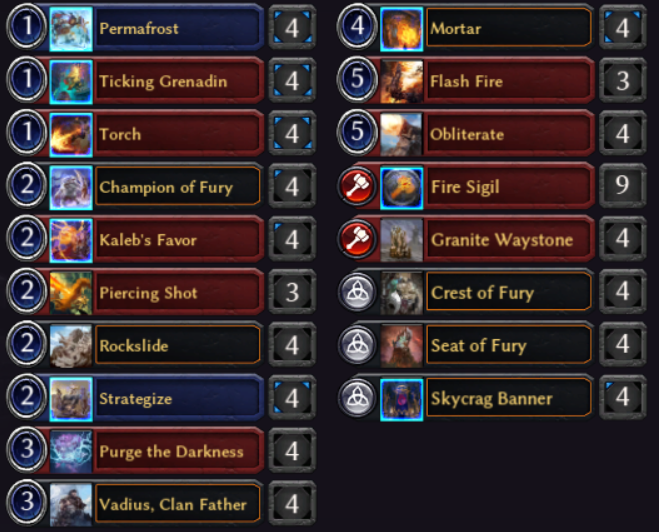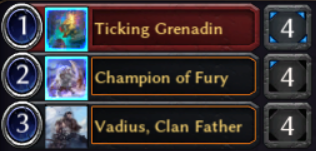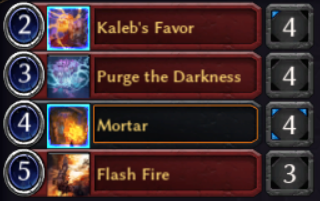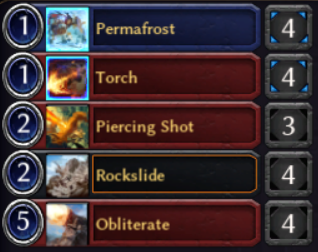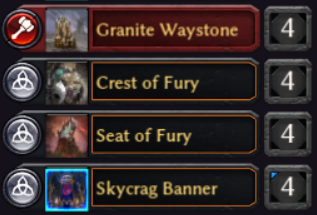MTG Arena: What to Craft First?
Many of us have been there before: a few days or weeks into a new digital TCG and we’re saved up enough resources to begin crafting a new deck — one strong enough to take down the toughest of opponents. And yet, when we navigate to the unowned section of our collection, we often find that we’re suddenly stuck — there are simply too many good cards to craft. In this article, I’m going to go over what I believe is the best strategy for spending your hard-earned wildcards, both short-term and long-term.
What makes a card a good craft?
There are several factors that determine the usefulness of a card — some cards are simply more valuable than others. There are four major factors that influence the utility of an individual card: power level, ubiquity, support cards, and the standard rotation.
Power Level
Pound for pound, some cards simply outmuscle the competition. Whether they have game-breaking effects, low mana costs, or both, there are plenty of examples of cards that are much stronger than the rest. When you craft a powerful card, you know that it will always perform well when you include it in your decks.
Ubiquity
Some cards are strong inclusions in almost any deck that can cast them. Crafting flexible cards will allow you to switch from deck to deck more easily, as you’ll be able to make use of cards already in your collection more often. Though not as flashy as the bombs in the previous section, these staples are more than reliable enough to get the job done.
Dual lands deserve a special mention because they’re the most ubiquitous type of rare in the game. Every deck aiming to play more than one color (and even several that are mono-colored with a light splash) will need several dual lands in order to function. Though there are budget alternatives for these — the cycle of common dual lands in M19 comes to mind — good dual lands are indispensable, and will always be the safest type of card to craft.
Required Support Cards
Not every card is easy to build a deck around on a budget. Many cards require that you include several other rares alongside them in order to operate properly, which makes them poor choices for crafting early on. Cards that have three or more colors will often require expensive mana bases with at least three or four playsets of dual lands, making them off-putting to newer players. Requiring ownership of dual lands isn’t the worst stipulation — after all, you’re sure that you’ll be able to make good use of those lands at some point — but there are several build-around rares that are even more restrictive than that. Equally powerful and demanding, crafting cards like these is not recommended until you already have a sizable collection.
The Standard Rotation
Knowing how much time a card has left in standard is important, especially for players who plan on slowly building up their collection. Cards in Kaldesh, Aether Revolt, Amonkhet, and Hour of Devastation have little time left in the sunlight before the rotation this October. Even cards that survive the rotation will be heavily affected by it — Goblin Chainwhirler is a powerful card, but most of the overpowered red four-drops that accompany it will be leaving us soon, and no one knows if Guilds of Ravnica will supply enough to fill the gap. Prioritizing cards that have a guaranteed lifespan will reward you down the line, especially for less invested players.
MTG Arena Card Tier List
With these four factors in mind, here is a tier list of every card I would recommend crafting to players looking to start their collection. Do note that the twelve Kaladesh block rares and mythics featured here will not be included in this analysis, as explaining why you should craft a card that everyone received four of for free is rather redundant. Keep in mind that this list is subjective, and the value of cards in it changes depending on your collection and play style — for example, the powerful red cards in the S-tier should be bumped up to S+ if you haven’t made your first deck yet.
Tier S+ — The Best of the Best
Cards in this tier are indispensable, ubiquitous, and survive the rotation, making them ideal candidates for crafting.
Ixalan dual lands, Dominaria dual lands — These “check lands” see play in almost every single deck in their colors. You will use these ten cards many, many times during their lifespan.
Rekindling Phoenix — Mono red has a slew of super-powerful four drops (and five drops, in Glorybringer’s case). What sets Rekindling Phoenix apart is that it survives the rotation — you’ll be seeing this card for a long time.
Vraska’s Contempt, Settle the Wreckage — Though these cards might not appear like they have much in common at first glance, they both do two very important things — exile creatures at instant speed. Many of the strongest threats in standard have haste and are resistant to destroy effects, making spells such as these indispensable for decks looking to prolong the game.
Search for Azcanta — In the early stages of the game it smooths out your draws and stocks up your graveyard, and in the late game simply activating this card every end step will bury most opponents. For a two mana, near-unkillable permanent, that’s an incredible deal. Every blue deck with enough spells to support the back half of this card will want at least two copies somewhere in the 75.
Teferi, Hero of Dominaria — Teferi is the hero of blue-white decks everywhere, as he is one of the most powerful planeswalkers printed in a long time. His plus pulls you ahead in both cards and mana, his minus answers almost anything, and his ultimate flat out wins you the game if it lasts more than a few turns. Add in Teferi’s secret mode — using his -3 on himself to stop yourself from decking — and you have an incredibly powerful five mana card.
Tier S — The Tournament Staples
Cards in this tier are powerful metagame staples that show up in many of the top lists in Standard. If you want to make a powerful deck, you’ll need the help of cards found here.
Amonkhet dual lands, Kaladesh dual lands — The only difference between these duals and the ones in the S+ tier is that these will be leaving us in October. These are still high value crafts despite their shorter lifespan.
Goblin Chainwhirler, Hazoret the Fervent, Glorybringer — The 3-4-5 punch of these cards is enough to bury any opponent who doesn’t come well prepared. These super-powerful cards all do something valuable the turn they come in to play, whether it be dealing damage to the opponent, their creatures, or both. If you enjoy playing Mountains, you should look into crafting these cards. The only thing keeping these cards out of the S+ tier is the rotation — in Goblin Chainwhirler’s case, the uncertainty of the future of mono-red that will be decided next October.
The Scarab God — The Scarab God both necessitates a removal spell immediately and punishes ones that merely send it to the graveyard, making it an extremely powerful finisher. Though this powerhouse has few days left in Standard, it’s sure to be a strong choice for the next two months.
Karn, Scion of Urza — Karn is a card advantage engine that can show up in any deck. Though he’s at his best in decks with enough artifacts to make his -2 ability stronger, any deck looking to refill its hand in the midgame will appreciate him. The fact that he’s colorless is his strongest feature, meaning you can use him in any deck you want to.
Champion of Wits — As an early drop that smooths out your early draws and a late-game win condition with its Eternalize ability, Champion of Wits fits into many decks, especially ones that appreciate its ability to fill up your graveyard.
Jadelight Ranger — This three-drop finds you lands early and spells late, with a respectable body to boot. On top of that, it has additional synergies with +1/+1 counter decks and with graveyard decks, making it a versatile role-player that is a worthy consideration in any green deck.
History of Benalia — Don’t let the Knight tribal aspect fool you — this is a very powerful card without any support. Two 2/2’s with vigilance is a good deal for three mana, and the third chapter of this saga is a nice bonus if they survive a couple of turns. Aggressive and controlling decks alike will make good use of this card.
Lyra Dawnbringer — This card dominates the battlefield, playing offense and defense supremely well. Few creatures can profitably attack into a 5/5 with first strike, and the combination of flying and lifelink make this card extremely difficult to race. If not for its vulnerability to removal spells, it would surely be an S+ card.
Carnage Tyrant — Do control decks have you down? The implacable death lizard is here to help. Tough to block and even tougher to remove, this card is a real beating against slower decks, in addition to any Dinosaur synergies you might be interested in.
Tier A — The Collection Testers
Cards in this tier are powerful in and against the top tier decks, but limited to fewer decks than cards in the S tier. You’ll need card in this tier to complete your strongest decks, but their lack of flexibility holds them back.
Nicol Bolas, the Ravager — This elder dragon really rewards you for meeting his demanding mana cost. Though he requires you to possess many dual lands in order to cast him, he packs a huge punch against every deck in the format. Once you have all the necessary dual lands and supporting rares necessary to build a deck around him, I highly recommend you give him a whirl.
Soul-Scar Mage, Earthshaker Khenra, Kari Zev, Skyship Raider, Pia Nalaar — Mono red has a long list of powerful early-game rares at its disposal. If you prefer to play the most aggressive deck possible, then these are good cards to craft. However, unlike the red cards in higher tiers, these cards only go in one deck.
God-Pharaoh’s Gift, Angel of Invention — Nicol Bolas’s Christmas present and its favorite partner in crime are a powerful combo. There are many different ways to build the deck, but they all do something very powerful in their own right. If you’ve already crafted Champion of Wits, crafting these two cards is a good start to a powerful deck.
Commit // Memory — It’s rare that blue gets a removal spell this good. Providing countermagic and board control for most permanent types in one package, Commit // Memory is a solid inclusion in many blue decks.
Cut // Ribbons — Red has an overabundance of removal spells in the two mana slot at the moment. Cut // Ribbons has the edge of being the only one that deals four damage naturally (Harnessed Lightning requires additional energy). If you want to improve your matchup against the green decks that feature several creatures that have four toughness, consider including this card.
Liliana, Death’s Majesty — A powerful inclusion in many black midrange decks, Liliana has a slew of strong creatures to reanimate, including The Scarab God, Nicol Bolas, and Torrential Gearhulk. If you’ve already crafted Champion of Wits, Liliana is one of the stronger planeswalkers to pair with it.
Scavenger Grounds — Many of the strongest cards in Standard make use of the graveyard, and Scavenger Grounds can shut them down at a low cost. Just make sure to not include too many colorless lands if your deck can’t support them.
Arguel’s Blood Fast — A little life is a meager price to pay for an endless supply of cards. Arguel’s Blood Fast is one of the best sideboard options against slower, more controlling decks available to black, and it’s so powerful in the right situation that including one in the maindeck is a viable choice.
Rhonas the Indomitable, Steel Leaf Champion, Ghalta Primal Hunger, Greenbelt Rampager, Thorn Lieutenant, Resilient Khenra — Though some might say it lives in mono red’s shadow, mono green aggro is a powerful option for those who prefer a little more meat on their creatures. These above-the-curve creatures will outsize the competition with ease. Just cross your fingers that you don’t run into too many Fumigates.
Skysoverign, Consul Flagship — A massive flier and a reasonable removal spell all in one, Skysoverign is a powerful addition to decks that have plenty of ways to crew it.
Rishkar, Peema Renegade — For those of you who want to play Winding Constrictor, this card is one of the best follow-ups to the turn 2 snake. If that isn’t your thing, I’d advise looking elsewhere.
Ajani, Adversary of Tyrants — Ajani is a powerful curve topper in an aggressive white deck. Your creatures will grow out of control quickly if unanswered, and his ultimate will simply bury your opponent in tokens.
Arch of Orazca — If you want to improve your deck’s late-game and you don’t mind running a colorless land, crafting one Arch is a reasonable choice.
Shalai, Voice of Plenty — Though deceiving at first, this angel has many uses. Spot removal spells are very common in standard, and she even protects you from Settle the Wreckage. She also has a respectable body and threatens to get out of hand very quickly if you have green mana. Plus, Shalai and Lyra are a match made in heaven.
Demanding Dragon — Though largely outclassed by Glorybringer, Demanding Dragon is a reasonable option for decks that wish they could play more than four 5-mana dragons. Additionally, Demanding Dragon does survive the rotation, meaning it could be a viable candidate come October.
Hostage Taker — Against creature decks that are low on removal spells, Hostage Taker can turn your opponent’s best creature against them. Don’t forget that it can exile artifacts too!
Angel of Sanctions — Doubling as a threat and a removal spell, Angel of Sanctions has uses in many decks, especially ones that aim to abuse the embalm ability.
Verix Bladewing — Verix is a strong option at both four and seven mana, and features a relevant creature type as well. Competition is quite stiff in red’s four mana slot these days, but Verix has his own niche at the moment and stands to do nothing but gain from the rotation.
Nexus of Fate — The star of the show in the new “turbo-fog” deck, Nexus of Fate is a powerful build-around card. If you already have Teferi
Tier B – The Sideboard Tier
Cards in this section tend to be situational but very useful once their situation arises.
Vivien Reid, Nissa Vital Force, Vraska Relic Seeker, Angrath the Flame-Chained, Ajani Unyielding, Nissa Steward of Elements, Nicol Bolas God-Pharaoh — Each of these planeswalkers is useful in different situations. They are all strong sideboard options for decks looking to improve their late game, and many of them could be usable in maindecks under the right circumstances.
Vizier of Many Faces — If you can’t beat ‘em, join ‘em. There are many powerful creatures worth copying in standard right now, especially strong hexproof threats such as Vinemare and Carnage Tyrant. Embalm is a powerful ability here, doubling the value of your card.
Sweltering Suns — Creature swarm decks are very popular in Standard, and this is a cheap way to deal with those strategies. It also cycles in situations where it’s useless, making it a reasonable maindeck inclusion for controlling red decks.
Sorcerous Spyglass — Many decks have cards with powerful activated abilities. Sorcerous Spyglass has uses in many matchups, with the additional upside of gaining information on your opponent’s hand. Colorless sideboard cards are useful in the construction of many different decks, making this a decent inclusion in your collection.
Authority of the Consuls — This card is extremely annoying on turn 1 against the red aggro decks. If you want to really solidify that matchup, this is a worthwhile inclusion in your sideboard.
Deathgorge Scavenger — Though this card doesn’t excel at any one role, it does do several things while also being a reasonable attacker, with a useful creature type in the right deck. If you want a swiss army knife that is good against graveyard decks and red decks, consider adding this card to your sideboard.
Hour of Glory — Though largely outclassed by Vraska’s Contempt, Hour of Glory is useful in a pinch in decks that can’t afford a double black spell.
Spit Flame — In decks that have at least four dragons, Spit Flame can be a powerful sideboard option.
Tezzeret, Artifice Master — Tezzeret protects himself reasonably well and rewards you well for playing an artifact deck. Unfortunately, most of his support will evaporate at rotation, leaving him with an uncertain future.
Sarkhan, Fireblood — This card is playable even in a deck without any dragons, though he does appreciate having Nicol Bolas and Glorybringer on his team. Three mana planeswalkers are quite powerful, as many opponents will not be set up to deal with them that early.
Banefire — A win condition against slow decks and a removal spell in a pinch, Banefire provides a unique effect to red decks that would appreciate uses for lands past the first five.
Resplendent Angel — Though a 3/3 flier for 3 isn’t a bad deal, gaining 5 life in one turn is a tall order for all but the most dedicated lifegain decks. This is a powerful card, but a lot of the cards that enable it aren’t anywhere near as powerful.
Approach of the Second Sun, Pull from Tomorrow, Nezahal Primal Tide, Chromium the Mutable — The sheer power of Teferi as a win condition makes each of these cards mostly unnecessary. They each have their own uses, and if you want the effect they’re all playable, but you don’t need any of these cards to play a control deck.
Lifecrafter’s Bestiary, Shapers’ Sanctuary — These two cards perform a similar role: making sure you have enough creatures to power through removal-heavy decks. They are both good at what they do, though LIfecrafter’s Bestiary is a much more powerful version of the effect.
Remorseful Cleric — Though graveyard-centric strategies aren’t prevalent at the moment, Remorseful Cleric comes with a reasonable body and some good utility.
Dusk // Dawn — In decks that play a lot of creatures with two or less power, this can be a strong one-sided sweeper and value engine all in one. Unfortunately, there aren’t many decks that fit that bill, and there also aren’t as many decks that this card shines against as you’d like. Still, if you want to create a white weenie deck, this can be a solid role-player.
Prowling Serpopard — Presenting a reasonable body and a very annoying ability against blue decks, Serpopard is a solid role-player.
Treasure Map — This colorless source of card advantage can be used in many decks. It does a little bit of everything, between smoothing out your early draws and giving you the option of a mana boost or a card boost in the mid to late game.
Glyph Keeper — Against purely reactive decks, Glyph Keeper can be quite powerful, sometimes requiring as many as four removal spells to contain the card entirely. However, the card is somewhat vulnerable to exiling removal spells that slower decks are sure to be playing.
Lost Legacy, Dispossess — If you’re in the market for a sledgehammer of a sideboard card, one of these two cards can strip combo decks of whatever card they need to win. Just remember that they’re very weak cards under normal circumstances —
Never // Return — Sometimes four Vraska’s Contempts isn’t enough. If you want more removal spells that can also hit planeswalkers, Never // Return is a reasonable option.
















